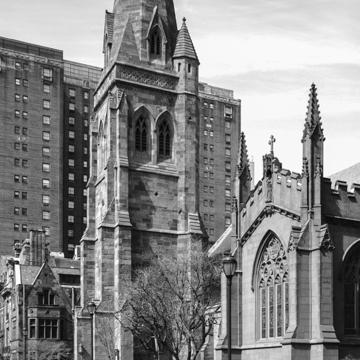The 1600 block of Locust Street is dominated by the splendid brownstone spire of this A. W. N. Pugin–inspired brownstone church. Built as the rage for Anglo-Catholic values swept English and elite American congregations, it marks the adaptation of the long chancel, separated from the nave by a rood screen that reestablished the hierarchy of the service—at the moment that other denominations were seeking inclusivity. The contrast with Notman's later Holy Trinity ( PH82) is particularly instructive. The three-aisle plan under an open truss above the nave incorporates the new Ruskinian value system of honesty with materials that would become the attribute of elite churches. In the manner of English parishes, the church grew by accretion, with a reddish sandstone Lady Chapel by Cope and Stewardson (1900) as a donation of the Wanamaker family. The main pulpit (1913) is the work of New Yorker Ralph Adams Cram, while the handsome doors with the crucifix in the tympanum are the work of Zantzinger and Borie (1924).
Across the street, a row of monumental brownstones, sometimes attributed to Notman, attest to the wealth of pre–Civil War Philadelphia. The post–Civil War McGregor Mitcheson House (1608 Locust Street) is one of Frank Furness's earliest houses. Wilson Eyre Jr.'s Art Nouveau bay at number 1628 for John Harrison in 1889 brings the aestheticized taste of the first bohemian moment to the city. In 2009, it was incorporated into a new dormitory by Venturi, Scott Brown and Associates for the nearby Curtis Institute of Music ( PH85). Proximity to St. Mark's kept the neighborhood fashionable into the early twentieth century.





















